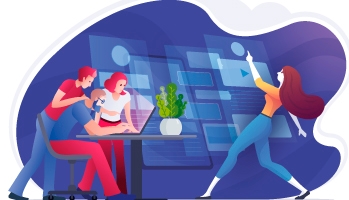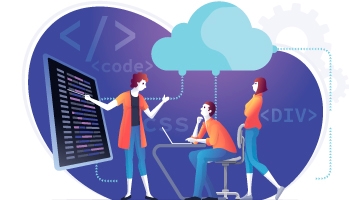Specialized Digital Magazines
How to attain new readers, advertisers and markets
“We have loyal readers who we did not have with our printed newspapers. This is an embryo because, given the results, we see that the possibilities can be enormous. We are looking for new niches and new formulae”



The achievement of niche magazines thought for digital circulation only has allowed El Economista, amongst other advantages, to expand and strengthen the number of its readers, reach new advertisers, developing a new partnership concept, and expand its brand on an international level. In the words of Deputy Director, Juanjo Santacana, “we have been pioneers in something, and are very proud of the result.”
El Economista (Madrid) born in 2006 to compete with Expansión (of Unidad Editorial) and Cinco Días (PRISA Group) in the confined space of financial information for the Spanish market. Its editor is ECOPRENSA, an independent company with no link to any newspaper group. It has a staff of around 130 professionals; the majority of whom are journalists.
The newspaper, of recognized quality and with awards from international institutions such as the SND, had poor growth prospects because of the characteristics of the Spanish financial sector. This situation of inaction was aggravated by the well-known decline in advertising investment which had caused the economic crisis.
ECOPRENSA is an independent company with no link to any newspaper group
On the other hand, the limited space of the printed media left ‘outside’ or greatly limited information concerning small and medium-sized enterprises, which accounted for 99% of the Spanish industrial structure.
El Economista had achieved remarkable success with an original idea: not having a publication on Mondays due to lack of profitability, but instead publishing SuperLunes, a new digital editorial in PDF format that could be downloaded for free, after registration, from its website. The 100,000 weekly downloads obtained - more than the combined daily printed circulation of 3 Spanish economic newspapers - enticing the imagination and experimentation in the digital world.
The possible necessary investment to do such experimentation should be reasonable and balanced.
The editorial analysis identified the major objectives:
Specialized products, to deepen sector information and are the benchmark for each respective professional association. Exclusively digital and disseminated only through the Web and digital platforms.
Free, but requiring registration-subscription.
Economically viable through sponsorship formulae.
High quality content, important to the sector. Editorial independence cannot be adversely affected by trade-advertising interests.
Embodying imaginative formulae so that potential sponsors understand that quality and independence benefit everyone.
Changing the mindsets in writing. Design and journalistic language must be adapted to the nature of the digital environment and their different reading modes: Web-browser, tablets, smartphones.
Maximum optimization of processing costs, production and dissemination.
Economic viability is guaranteed from the beginning with sponsorship formulae
The set objectives were analyzed and developed in three main work areas:
Technology:
In collaboration with Protecmedia, technological partner, it was decided to use the same publishing solution MILEMIUM, for the development-production-dissemination of these digital magazines, which is already used in the printed newspaper. Therefore, it does not have to make any technology investment at the infrastructure level.
It aims for a horizontal format and analyzed in detail the most appropriate fonts, in order to facilitate and make pleasant reading on digital devices.
For display on Tablets and Smartphones iOS and Android, the native App “Universal Viewer” developed by Protecmedia is chosen, to resolve the management of digital kiosk in a comprehensive way and the consistent and uniform reading of the various publications, regardless of the type of device.
Tests show the feasibility and benefits of the approach made.
Training:
El Economista carries out an intensive and extensive internal training programme among the editorial staff to mentalize professionals in new ways of thinking, writing - especially the headlines - and communicating in the digital ecosystem. Journalists understand and assimilate that what is important is the information, content, and not the support. A high degree of motivation and involvement is achieved with the project.
Some workflows were reorganized to optimize and improve efficiency. But, above all, redistributing responsibilities without increasing the workforce. Each magazine will have a responsible editor and a deputy who will help out when necessary. The rest of the editorial staff will work on all publications, whether magazines or newspapers on any channel or format.
The publications are free, but require registration-subscription
Business Model:
A work team composed of the publishing and commercial areas think the best way to make these publishing products profitable from the first issue, based on the free-of-charge premise with a registration-subscription requirement.
In addition to attracting large companies in each sector, the focus is on getting sponsors among medium-sized and small businesses, making them see that from now on they will have media hosting information of interest to them with appropriate quality and in-depth processing.
Always safeguarding independence, thematic suggestions from these sponsors will be heard with special attention.
The ultimate goal is that the sponsor and /or advertiser is satisfied to see his image associated with a quality publication and whether he advertises in it or not, he is contributing to the dissemination of important issues for the sector.
Technological:
20 monthly magazines have been identified in 3 years, and nowadays they are leaders in their respective sectors. They are done with an integrated editorial office and optimized workflow, without reworking or adaption of content for broadcast channel requirements or medium type final display.
It has reached a high level of production and automation.
The related capital expenditure associated with the business model and increase of workload has been minimal.
Editorial:
Strengthening and internationalization of the brand El Economista, it is always linked to the header of each magazine. First European website for economic information for Spanish and Portuguese speakers and second worldwide after World Street Journal.
Attainment of new readers in the domestic and foreign markets. The opening of 5 offices in Latin America with a main newspaper office in Mexico City which has its own web domain registration economiahoy.mx due to local registration issues.
Increase and enrichment of information sources in niche sectors, which they did not have before. Involvement and positive contribution of partners-sponsors. Leadership in specialized subject matter.
Ability to analyze and know the habits and behaviour of readers better. Geo-location of communities of readers.
Good SEO positioning, thanks in part to generic names - Water, Health, Energy, etc. that identify headboard sector.
Consolidation of “virtuous cycle”: social network (Twitter) - specific minisite industry - specialized magazine which replicate the tripod that has always characterized the press: news - information - story/analysis.
“Training and commitment from our employees are fundamental.” The 20 monthly magazines, leaders in their respective sectors, have not required any increase in staff, thanks to the high productivity MILENIUM offers.
Economic:
Every magazine is profitable.
Strengthening of contacts and Sponsors’ portfolio.
Financial stability: a total of 150 sponsors-partners are committed to the various publications on a medium term basis.
Currently, with the Web, 60% of ECOPRENSA-El Economista´s revenue comes from the digital world; the other 40% comes from the hard-copy output.










 )
)